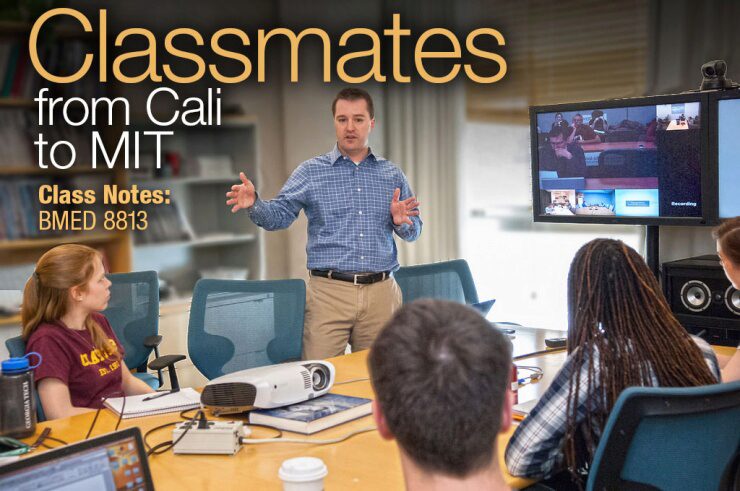The 10 graduate students are discussing stem cell population analysis, when it’s time. Before they can continue the discussion, Todd McDevitt, the instructor, has to do one thing — turn on the TV.

“That’s the beauty of this class, not only is the topic of stem cell engineering unique, but thanks to video conferencing technology, Georgia Tech students can now take a class with their peers from across the country,” said McDevitt, an associate professor in the Wallace H. Coulter Department of Biomedical Engineering and the George W. Woodruff School of Mechanical Engineering.
Stem Cell Engineering (BMED 8813) has been offered since the spring of 2011 and was created by McDevitt as a way to educate graduate students about a research area that is becoming increasingly popular.
Including the 10 students at Tech, there are 39 students enrolled in this semester’s course. Aside from Tech, they are located at Washington University, the Massachusetts Institute of Technology, Boston University, University of California, Merced, and the University of Wisconsin. And although this is a graduate-level course, undergraduates can take the course with McDevitt’s permission.
So what can students expect during a week of classes? On Tuesdays, students from all of the participating campuses hear a lecture via the video conferencing system on a stem cell engineering topic — think everything from stem cell biology basics to stem cell biomanufacturing.
When the class meets on Thursdays, two students (at each location) typically lead a 50-minute discussion on a recently published journal article related to the lecture topic to their in-person peers.
Then, for the remainder of class, the Tech group video conferences with the students at other locations to discuss the key points brought up by each local group.
“It’s very helpful to have the perspective of students and faculty from other universities,” said Jenna Wilson, a Ph.D. student in the bioengineering program who is a former student of the course turned teaching assistant. “Because people at other universities have different areas of research expertise, they can provide greater insight into aspects of the stem cell engineering field and pose interesting questions for discussion.”
Wilson also appreciated the small class size and discussion format of the course.
“Both aspects allow for great conversations with other students and some of the leading faculty in the stem cell engineering field,” she added. “Even though the class is broadcast across six universities, it's still a small group where you can feel comfortable sharing ideas and opinions.”
The course is typically offered during spring semester. For more information, email McDevitt.
Additional Information
Class Code: BMED 8813
Professor: Todd McDevitt
Class Size: 10 students (39 total at all of the participating campuses)
Extra: There are subject-matter guest lecturers who participate in class from across the country (via video conferencing) throughout the semester.
Writer: Amelia Pavlik, Institute Communications
